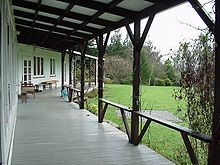This articleneeds additional citations forverification.(January 2021) |
Averanda(also spelledverandahinAustralianandNew Zealand English) is aroofed,open-airhallwayorporch,attached to the outside of a building.[1][2]A veranda is often partly enclosed by arailingand frequently extends across the front and sides of the structure.[3]


Although the formverandahis correct and very common, some authorities prefer the version without an "h" (theConcise Oxford English Dictionarygives the "h" version as a variant andThe Guardian Style Guidesays "veranda not verandah" ).[4]Australia'sMacquarie Dictionaryprefersverandah.[5]
Etymology
editVeranda,as used in the United Kingdom and France, was brought by the British from India (Hindi:बरामदा). While the exact origin of the word is unknown, scholars suggest that the word may have originated in India or may have been adopted from thePortugueseand spread further to the British and French colonists.[6]Ancient and medieval Indian texts on domestic architecture likeVastu shastrauses the word"Alinda"for this architectural feature.[7]
Architecture styles notable for verandas
editAustralia
editThe veranda has featured quite prominently inAustralianvernacular architecture and first became widespread in colonial buildings during the 1850s. TheVictorian Filigree architecture styleis used by residential (particularlyterraced houses in Australiaand New Zealand) and commercial buildings (particularlyhotels) across Australia and features decorative screens of wrought iron, cast iron "lace" or wood fretwork. TheQueenslanderis a style of residential construction inQueensland,Australia, which is adapted to subtropical climates and characterized in part by its large verandas, which sometimes encircle the entire house.
Brazil
editThebandeiristastyle house from Brazil typically has a veranda positioned to face the sunrise.[8]
Hong Kong
editIn Hong Kong, verandas often appear on the upper floor of the first to third generations of Tong Lau (shophouses) due to a lack of space since the 19th century.
India
editEarly known examples of verandah in domestic architecture come fromVastu shastratexts which lay out plans and describe methods to build houses, wherealinda(veranda) is a common feature of domestic buildings.[9]
Porches were a natural idea in India, a mostly warm, tropical country. In Gujarat the porch area is called theotalaand in the Hindi belt it is known asalinda.These structures are not only used to cool off, but also as a centre of social life where neighbours can talk and kids play, or as a religious centre where rituals and worship of certain Gods can take place.[10]
In Southern India, the termthinnaiis used, and these structures are very common. This area serves a religious purpose in addition to a social one, and is the centre of everyday life for many.[11]Konkan's architecture is influenced by nature. It is sustainable and cost-effective. In Konkan traditional architecture, the veranda is calledotti,a semi-open space with low seating covered with a permanent roof. It serves as a transition space leading to an enclosed environment. Sometimes the sides are covered by woodenjaliwalls. It offers a temporary resting space to house members during the afternoon and evening.
Japan
editIn regions with heavy snowfall, especiallyAomoriandNiigataprefectures, structures called Gangi-Zukuri (ja: Nhạn mộc tạo) have been developed since theEdo period.For example, the total length of Gangi inold Takada cityis over 16 Kilometers.[12]
Poland
editIn Poland, the word "weranda" is commonly used for the unheated roofed annex to a house, without walls or with glass walls.[citation needed]
Sri Lanka
editIn Sri Lanka, verandahs original derivation was from traditional vernacular architecture and are known as"Pila"in Sinhalese. Both front and rear veranda examples are also known and common feature in local vernacular architecture.[13][14][15][16]Traditionally, domestic vernacular architecture layouts were also influenced by Sri Lankan BuddhistManjusri Vasthu Vidya Sastratext, which in turn was influenced by IndianVastu Shastratexts.[17]
United States
editTheCreole townhouseinNew Orleans, Louisiana,is also noted for its prominent use of verandas. In fact, most houses constructed in theSouthern United Statesbefore the advent ofair conditioningwere built with a covered front porch or veranda.
Spanish Colonial architecture(as well as the "Mission style" revivalist version that became popular in the Western United States in the early 1900s) commonly incorporates verandas, both on the exterior of buildings and, in cases of buildings with courtyards, along the interior walls of courtyards. In some cases, homes were constructed with every room opening into a courtyard veranda, rather than interior corridors or direct connections to other rooms.
See also
editReferences
edit- ^Poppeliers, John C. (1983).What Style is it?.New York: John Wiley & Sons. p.106.ISBN0-471-14434-7.
- ^"Glossary of Anglo-Indian words - Veranda".University of Chicago. Archived fromthe originalon 2021-01-01.Retrieved2015-07-08.
- ^Ching, Francis D.K. (1995).A Visual Dictionary of Architecture.New York: John Wiley and Sons. p. 25.ISBN0-471-28451-3.
- ^"Guardian and Observer style guide: V | Info | the Guardian".TheGuardian.com.Archivedfrom the original on 2014-01-21.Retrieved2016-12-18.The Guardian Style Guide
- ^"Macquarie Dictionary".www.macquariedictionary.com.au.
- ^Burnell, A. C.; Yule, Henry (2018-10-24).Hobson-Jobson: Glossary of Colloquial Anglo-Indian Words And Phrases.Routledge.ISBN978-1-136-60331-0.
- ^Chakrabarti, Vibhuti (11 January 2013).Indian Architectural Theory and Practice: Contemporary Uses of Vastu Vidya.Routledge. p. 156.ISBN978-1-136-77882-7.
- ^Cardinal-Pett, Clare (2015).A History of Architecture and Urbanism in the Americas.Routledge.ISBN978-1317431244.Retrieved30 September2016.
- ^Chakrabarti, Vibhuti (11 January 2013).Indian Architectural Theory and Practice: Contemporary Uses of Vastu Vidya.Routledge. p. 156.ISBN978-1-136-77882-7.
- ^"Traditional Pol Houses of Ahmedabad: An Overview".
- ^Mohanram, Anupama (22 April 2022)."Why we need the thinnai".The Hindu.
- ^Gangi Dori (covered walkways)Joetsu Information Web Site
- ^Ariyawansa, R. G.; Udawattha, C.; Prabodhya, S. (2021)."A Review of Ancient Built Environment Property Standards of Sri Lanka".DSpace Repository - University of Sri Jayewardenepura.
- ^Mehjabeen Ratree, Sabrina; Farah, Nuzhat; Shadat, Shariful (2020). "Vernacular Architecture of South Asia: Exploring Passive Design Strategies of Traditional Houses in Warm Humid Climate of Bangladesh and Sri Lanka".Proceedings Article.pp. 216–226.doi:10.38027/n212020iccaua316262.ISBN9786056824395.
- ^Tucker, Simon; Gamage, Arosha; Wijeyesekera, Chitral (1 January 2014). "Some design aspects of sustainable post-disaster housing".International Journal of Disaster Resilience in the Built Environment.5(2): 163–181.doi:10.1108/IJDRBE-06-2012-0019.ISSN1759-5908.
- ^Pieris, Anoma (25 October 2018)."Sovereignty, Space and Civil War in Sri Lanka: Porous Nation".Routledge.ISBN978-1-351-24632-3.
- ^Marasinghe, E. W. (1989).The Vastuvidya Sastra ascribed to Manjusri (Sanskrit Text with English Translation).Sri Satguru Publications.ISBN8170301998.